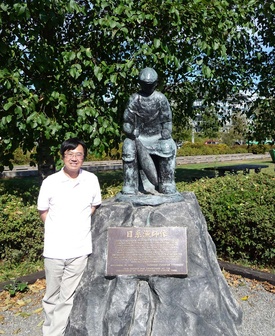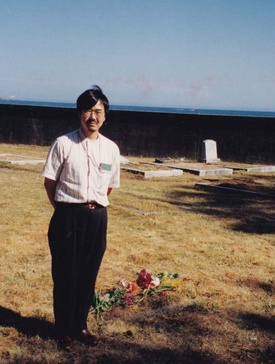The Monterey Bay Aquarium, famous for its excellent displays of marine life native to California, is located at the end of Cannery Row, a tourist spot lined with seafood restaurants and souvenir shops. As the name Cannery suggests, this area is a port town that prospered mainly around sardine canneries. Surprisingly, before the war, 80 percent of the port facilities in Monterey Bay, including the current Cannery Row, were owned by Japanese immigrants. However, this historical fact is hardly mentioned in the history of Japanese immigration in the Bay Area, except in publications by local historians and museum exhibits.
The majority of studies on Japanese people in North America take it for granted that Japanese immigrants made their living from agriculture. In contrast, this book, "A Historical Geography of Japanese Fishing Immigrants in Canada," which recently won the 4th Japan Association for Canadian Studies Award, sheds light on Japanese immigrants who, like those in Monterey, made fishing and fishing-related jobs, which have been overlooked in studies of Japanese people in Canada.
The research area covers the area from Steveston, British Columbia on the west coast of Canada to Vancouver Island, as well as the Skeener River basin and the Queen Charlotte Islands in the northwest. The activities of Japanese immigrants surrounding fishery resources, such as salmon migrating up the Fraser River in Steveston and whales and herring on Vancouver Island, are the subject of analysis.
This book does not use the dichotomous terms "fishing immigrants" versus "agricultural immigrants." This is because immigrants who made their living from fishing in their new home were not necessarily from fishing villages with experience in the fishing industry, and it is also necessary to consider the activities of Japanese immigrants who worked in various jobs derived from fishing. Therefore, this book uses the term "fishery immigrants" to include Japanese immigrants who worked in fishing-related jobs on land, such as fish processing, shipbuilding, and distribution, in addition to those who worked in fishing at sea. Accordingly, this book does not separate fishermen from fishery-related businesses in its spatial analysis. The term "cannery," which combines the space from the fishing grounds at sea to the canneries, housing for workers, drying areas for fishing nets, and shipyards on land, is used as a spatial unit to understand the activities of fishing immigrants.
This book, which covers a period of about 50 years from the early days of immigration at the end of the 19th century to the forced internment of Japanese Canadians, is made up of nine chapters. Chapters 1 and 2 define important terms in this book, such as fishing immigrants and cannaries, and then present the research objectives by reviewing research on the history of Japanese Canadian immigration in North America and Japan. Furthermore, the significance of a historical geographical approach in the study of Japanese fishing immigrants in Canada is discussed.

In addition, Chapter 3 provides a new overview of the history of Japanese immigration to Canada, providing a foundation for understanding the following chapters even for readers who are not specialists in Canadian immigration history.
The next three chapters provide specific examples of the activities of Japanese fishery immigrants in Canada for each type of fish. Chapter 4 focuses on the salmon canning industry, providing a detailed description of the spatial layout of canneries from historical sources. Furthermore, the book details the division of labor between Japanese immigrants and workers of other ethnicities within canneries, based on how canneries developed in British Columbia.
The following chapter, Chapter 5, examines Japanese immigrants involved in the whaling industry, which has received even less attention in the few studies of fishery immigrants that have been conducted. It is clarified that, unlike immigrants to the salmon canning industry, who were directly involved in fishing, Japanese immigrants to the whaling industry moved around according to the season and played a supporting role in whaling bases and whale oil collection.
Meanwhile, the salted herring manufacturing industry, which is discussed in Chapter 6, was once dominated by Japanese immigrants. The salted herring produced was exported to Japan and to colonies during the Pacific War, and it is considered that it influenced local food culture.
Chapter 7 examines the newly discovered fishing grounds and fishing village development on the west coast of Vancouver Island at the beginning of the 20th century. It clarifies how the recession and damage caused by fires at salmon canning factories, combined with the trend toward motorized fishing boats, led to the development of new fishing villages. It shows that a social division of labor was established based on place of origin, with people from fishing villages and non-fishing villages cooperating with each other.
Chapter 8 examines the people who were involved in the fishing boat building and food sales industries that supported the Japanese immigrants whose main activity was the fishing industry, as discussed in the previous chapters.
In the concluding chapter, Chapter 9, based on the detailed case studies and discussions presented above, a model of the movement and living space of Japanese fishing immigrants is presented. Finally, it is concluded that Japanese fishing immigrants were incorporated into an international division of labor system related to ethnicity and country of origin, and that although they were differentiated within spaces such as canneries, they contributed to the development of the Canadian fishing industry and played an active role.
Below, I will list two attractive aspects of this book from my perspective.

First, there is a remarkable wealth of historical materials. Not only are there analyses of standard materials in Japanese immigration research, such as newspapers, address books, and Japanese name lists from local Japanese newspapers, but also a large amount of materials in both Japanese and English, such as fire insurance maps, field investigation reports from Japanese government agencies, passports, family registers, account books, and checks, are analyzed. The addition of oral histories and old local photographs makes it possible to understand in detail everything from international migration to blood relations. The table on page 55, which is compiled taking into account spatial scale, is a must-have reference for anyone who will be researching the history of Japanese immigration in the future. Personally, I found it interesting that the lives of women in fishing villages were revealed through materials such as announcements from women's associations and newspaper articles about Japanese language school graduation ceremonies, and I was able to get a glimpse into their daily lives.
Secondly, the author interprets the materials and presents them to the reader while appropriately changing the spatial and temporal scales for each theme. The model diagram of living space presented in Chapter 9 may be applicable to the analysis of the activity space of fishing immigrants, which has not yet been studied, such as the Monterey cannery mentioned above, and this is expected to deepen future research on North American fishing immigrants. In addition, the range of spatial scale is not limited to Canada and Japan, but extends to the colonial areas during the Pacific War, which maximizes the advantages of using spatial scale as an analytical method.
This book is recommended not only for readers interested in the fishing industry and immigration research, but also for beginners who study groups and space. Some readers may hesitate to pick up this book because the fishing industry in the title is a niche subject of analysis in the study of Japanese immigrants in Canada. However, as you actually read through it, you will find it very easy to understand, as the selection of materials to be analyzed, the analysis method, and the conclusion are written in detail and clearly. This is why you can compare it with your own research and interests. I wish I had read this book before conducting my first field research and writing my first paper. This is why I think this book is an excellent book that can serve as a model for research books not only in historical geography but also in many other fields.
Norifumi Kawahara, " Historical Geography of Japanese Fisheries Immigrants in Canada "
(Kokon Shoin, 2021)
© 2022 Chisa Matsunaga



